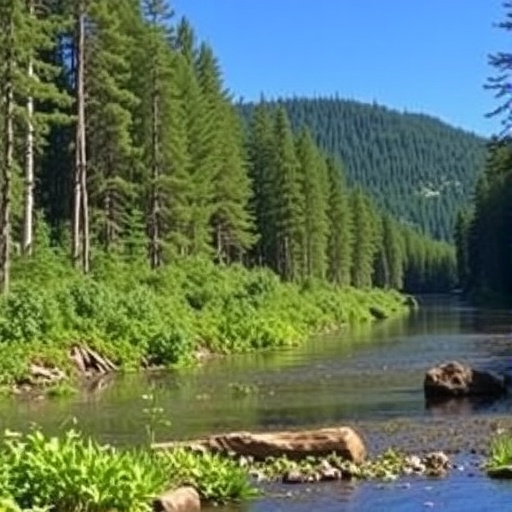For decades, conventional wisdom has positioned forests as water consumers—ecosystems that, by virtue of evapotranspiration, reduce the availability of water downstream. This simplistic narrative has influenced forest management policies worldwide, often discouraging large-scale reforestation projects in regions where water scarcity looms as a critical challenge. However, a transformative body of research, recently synthesized in the journal Forest Ecosystems, is turning this long-held belief on its head. Emerging evidence now indicates that, under precise ecological and geographical conditions, restoring forest landscapes can significantly enhance water availability, especially during dry seasons when water is most needed.
This breakthrough synthesis, led by an international team of scientists affiliated with King’s College London and other institutions, meticulously analyzes the hydrological consequences of large-scale forest landscape restoration (FLR). The study stresses a paradigm shift: prioritizing the recovery of dry-season river baseflow over total annual water yield. Crucially, baseflow—the steady, low-level flow in rivers sustained by groundwater—is vital for maintaining ecosystems, agricultural productivity, and human consumption during arid intervals.
The research underscores the role of restored forests in rehabilitating the soil’s inherent capacity to act as a water reservoir or “sponge.” Tree roots penetrate and fracture compacted soils, while accumulated organic matter improves soil porosity and permeability. This enhanced soil matrix promotes greater infiltration of precipitation, leading to replenished groundwater storage. Remarkably, these hydrological benefits can offset, and even surpass, water lost through evapotranspiration by the trees, culminating in a net increase in baseflow in many landscapes.
“It’s a striking revelation,” said Dr. L. Adrian Bruijnzeel, corresponding author and hydrologist, “that forest restoration does not invariably equate to diminished streamflow, but can, on the contrary, invigorate flow during dry spells.” This nuanced understanding challenges entrenched hydrological dogma and opens new avenues for using forests as strategic tools for water management and climate resilience.
Still, the study is clear that outcomes are not uniform. The positive hydrological impacts of forest restoration hinge on a combination of local factors such as rainfall seasonality, soil depth, and land degradation status. Seasonal climates with distinct wet and dry periods, deep soil profiles capable of storing ample groundwater, and landscapes suffering past deforestation or degradation show the most promise for water yield improvements following FLR interventions.
Vegetation selection emerges as another critical determinant in restoring hydrological balance. The research cautions against blanket plantation of fast-growing exotic species in already water-limited environments, where such choices could exacerbate scarcity. Instead, the authors advocate for native species assemblages, age-diverse forests, and integrated agroforestry models. These approaches maintain intermediate canopy densities that optimize water infiltration while curbing excessive transpiration losses.
Beyond local catchments, the hydrological influence of restored forests extends to regional climates via atmospheric moisture recycling. Evaporation and transpiration from forest canopies contribute moisture to downwind precipitation patterns, effectively redistributing water resources and bolstering agricultural productivity far beyond the forest margins. In particular, coastal and mountainous ecosystems benefit from forests capturing water not only from rainfall but also from fog and low-lying clouds, enhancing ecosystem water inputs in unique ways.
Despite these advances, the authors underscore considerable gaps in knowledge, particularly regarding the long-term trade-offs between water use by trees and soil water replenishment. They call for comprehensive, longitudinal studies encompassing soil science, hydrology, and climate modeling disciplines to unravel complex feedback loops and inform restoration strategies resilient under global environmental change.
To implement forest restoration as a genuine instrument of water security, biodiversity conservation, and climate adaptation requires meticulous planning. It entails planting the right tree species in the right locations—tailored to local hydrology, soil characteristics, and climate regimes. Such strategic deployment turns forests from perceived water liabilities into reliable water assets, supporting both ecological integrity and human livelihoods.
The implications of this work resonate across environmental policy and management spheres. Reframing forests as modulators rather than mere consumers of water could galvanize more ambitious restoration initiatives worldwide, particularly in tropical and sub-tropical regions where land degradation and water stress intersect profoundly. It also positions forest landscape restoration as a vital nature-based solution in the portfolio of measures addressing global water security challenges amidst climate volatility.
In summation, the new research dispels the myth that more trees inevitably drain water resources. Instead, it presents forest restoration as a sophisticated hydrological intervention with the power to revitalize groundwater reserves, stabilize dry-season river flows, and enhance regional water cycles—ultimately fostering resilient ecosystems and communities. As restoration projects meet the dual imperatives of ecological sustainability and water stewardship, our understanding of forests must evolve—from solely carbon sinks to pivotal hydrological engineers shaping the future of water on Earth.
Subject of Research: Hydrological impacts of large-scale forest landscape restoration on groundwater recharge and dry-season river flows in tropical and subtropical degraded lands.
Article Title: Potential for improved groundwater recharge and dry-season flows through forest landscape restoration on degraded lands in the tropics
News Publication Date: 8-Sep-2025
Web References: DOI link
Image Credits: L. Adrian Bruijnzeel, Jorge L. Peña-Arancibia, Douglas Sheil, Alan D. Ziegler, Jun Zhang, Bob W. Zwartendijk, Christian Birkel, Ge Sun, Yanhui Wang, Xiaoping Zhang
Keywords: Forest landscape restoration, groundwater recharge, dry-season baseflow, hydrology, soil infiltration, tropical ecosystems, water security, climate resilience, native species, agroforestry, moisture recycling




